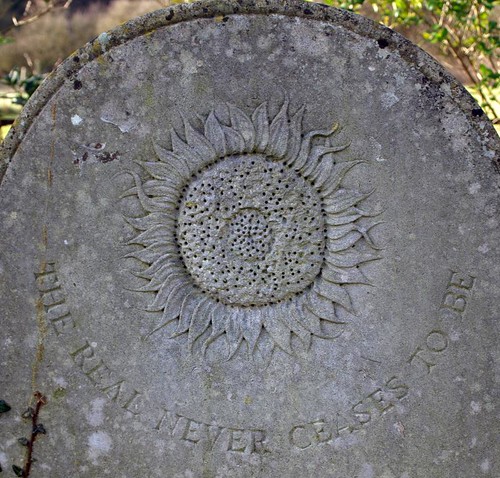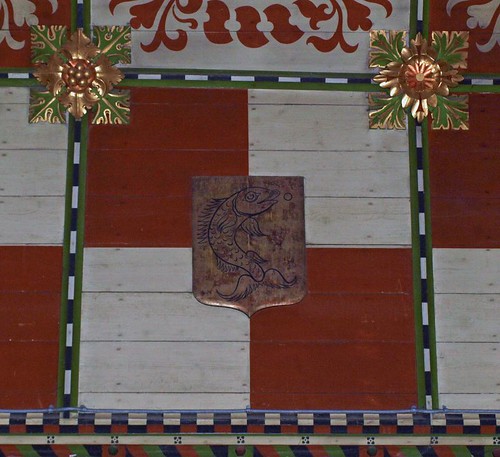ST PETER, 1870-1, by Thomas Jekyll, the Japan enthusiast who designed the woodwork for Whistler’s Peacock Room. Of this un-Victorian sense of romance and delicacy the E.E. exterior of Lilley church betrays nothing (except perhaps for the brick and stone chequerwork parapet to the SW tower). On entering, however, one is puzzled by the fact that the porch under the tower is red-brick lined. The church itself is flint. Otherwise only a few indications of anything out of the ordinary run of churches. The chancel, for example, is not paved with red and yellow Minton or Maw encaustic tiles, as one might expect, but with tiles in two shades of soft green with an occasional sang-de-boeuf. The chancel ceiling is handsomely painted. Of the medieval church one feature remains: the plain Norman N arch in the chancel. It is of red stone, unmoulded, on the simplest imposts.
Lilley. Rupert Brooke knew it well and brings it into one of his poems; here he would walk when he was at Cambridge University, by
The Roman road to Wendover,
By Tring and Lilley H00.
A rampant lion raises it head on cottage wall and gatepost, the crest of the Docwra family who lived in the fine park of Putteridge Bury generations ago. All that is left of the church they knew is the Norman chancel arch which has been reset in the chancel wall, the linen-fold panels and the old oak of the pulpit, which came from St John’s College, Cambridge, the piscina, and the 15th-century font at which were baptised a 17th-century curate’s two sons, John and James Janeway. John was a mathematical genius; James seemed at one time something like a rival to John Bunyan. They built a chapel for him in Jamaica Row at Rotherhithe, and there he preached while plague and persecution were rife, escaping both to die of consumption in 1674.
Today he is a literary curiosity, and it is almost incredible to read the books he wrote; yet for generations he was Bunyan’s only rival as an author for children. The moral blight that spread through England with the Restoration brought its reaction, and for a time there was a fashion in such books as James Janeway’s, one of which was called by the terrible title, A Token for Children, Being an Account of the Conversion, Holy and Exemplary Lives, and Joyful Deaths of Several Young Children. It was the book that upright parents gave their little ones in those days. To the parents the author would say, “Your child is never too little to go to hell,” and to the children he would warn them to pray and weep by themselves.
His heroes and heroines all die, monuments of piety and virtue, at the tenderest age, and William Godwin (Shelley’s father-in-law) who was brought up on the book, declared that he was so fired to emulation by their example that he felt willing to die with them “if I could with equal success engage the admiration of my friends and mankind.” A six-year-old Janeway hero whose brothers had not said grace before the meal asks them, “Dare you do this? God be merciful to us, this bit of bread might choke us.” He and others make a perfect end, and the author asks his little readers, “Are you like these children? Are you willing to go to hell to be burned with the devil and his angels?” A little girl in the book, surveying herself in a mirror, cries:
What a pity such a pretty maid
As I should go to hell.
It is terrible, but it is English, and the children who read this Janeway book created our Augustan age of literature and played their parts in building up the British Empire.
The Roman road to Wendover,
By Tring and Lilley H00.
A rampant lion raises it head on cottage wall and gatepost, the crest of the Docwra family who lived in the fine park of Putteridge Bury generations ago. All that is left of the church they knew is the Norman chancel arch which has been reset in the chancel wall, the linen-fold panels and the old oak of the pulpit, which came from St John’s College, Cambridge, the piscina, and the 15th-century font at which were baptised a 17th-century curate’s two sons, John and James Janeway. John was a mathematical genius; James seemed at one time something like a rival to John Bunyan. They built a chapel for him in Jamaica Row at Rotherhithe, and there he preached while plague and persecution were rife, escaping both to die of consumption in 1674.
Today he is a literary curiosity, and it is almost incredible to read the books he wrote; yet for generations he was Bunyan’s only rival as an author for children. The moral blight that spread through England with the Restoration brought its reaction, and for a time there was a fashion in such books as James Janeway’s, one of which was called by the terrible title, A Token for Children, Being an Account of the Conversion, Holy and Exemplary Lives, and Joyful Deaths of Several Young Children. It was the book that upright parents gave their little ones in those days. To the parents the author would say, “Your child is never too little to go to hell,” and to the children he would warn them to pray and weep by themselves.
His heroes and heroines all die, monuments of piety and virtue, at the tenderest age, and William Godwin (Shelley’s father-in-law) who was brought up on the book, declared that he was so fired to emulation by their example that he felt willing to die with them “if I could with equal success engage the admiration of my friends and mankind.” A six-year-old Janeway hero whose brothers had not said grace before the meal asks them, “Dare you do this? God be merciful to us, this bit of bread might choke us.” He and others make a perfect end, and the author asks his little readers, “Are you like these children? Are you willing to go to hell to be burned with the devil and his angels?” A little girl in the book, surveying herself in a mirror, cries:
What a pity such a pretty maid
As I should go to hell.
It is terrible, but it is English, and the children who read this Janeway book created our Augustan age of literature and played their parts in building up the British Empire.


No comments:
Post a Comment